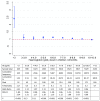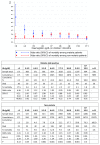Informing thresholds for paediatric transfusion in Africa: the need for a trial
- PMID: 31633055
- PMCID: PMC6784792
- DOI: 10.12688/wellcomeopenres.15003.2
Informing thresholds for paediatric transfusion in Africa: the need for a trial
Abstract
Background: Owing to inadequate supplies of donor blood for transfusion in sub-Saharan Africa (sSA) World Health Organization paediatric guidelines recommend restrictive transfusion practices, based on expert opinion. We examined whether survival amongst hospitalised children by admission haemoglobin and whether this was influenced by malaria infection and/or transfusion. Methods: A retrospective analysis of standardised clinical digital records in an unselected population of children admitted to a rural hospital in Kenya over an 8-year period. We describe baseline parameters with respect to categories of anaemia and outcome (in-hospital death) by haemoglobin (Hb), malaria and transfusion status. Results: Among 29,226 children, 1,143 (3.9%) had profound anaemia (Hb <4g/dl) and 3,469 (11.9%) had severe anaemia (Hb 4-6g/d). In-hospital mortality rate was 97/1,143 (8.5%) if Hb<4g/dl or 164/2,326 (7.1%) in those with severe anaemia (Hb ≥4.0-<6g/dl). Admission Hb <3g/dl was associated with higher risk of death versus those with higher Hbs (OR=2.41 (95%CI: 1.8 - 3.24; P<0.001), increasing to OR=6.36, (95%CI: 4.21-9.62; P<0.001) in malaria positive children. Conversely, mortality in non-malaria admissions was unrelated to Hb level. Transfusion was associated with a non-significant improvement in outcome if Hb<3g/dl (malaria-only) OR 0.72 (95%CI 0.29 - 1.78), albeit the number of cases were too few to show a statistical difference. For those with Hb levels above 4g/dl, mortality was significantly higher in those receiving a transfusion compared to the non-transfused group. For non-malarial cases, transfusion did not affect survival-status, irrespective of baseline Hb level compared to children who were not transfused at higher Hb levels. Conclusion: Although severe anaemia is common among children admitted to hospital in sSA (~16%), our data do not indicate that outcome is improved by transfusion irrespective of malaria status. Given the limitations of observational studies, clinical trials investigating the role of transfusion in outcomes in children with severe anaemia are warranted.
Keywords: Africa; Children; Guidelines; Kenya; Malaria; Mortality; Sepsis; Severe Anaemia; Transfusion.
Copyright: © 2019 Maitland K et al.
Conflict of interest statement
No competing interests were disclosed.
Figures



References
-
- The prevention and management of severe anaemia in children in malaria-endemic regions of Africa: a review of research. Geneva: World Health Organization,2001.
-
- Global status report on blood safety and availability 2016. Geneva: World Health Organization,2017. Reference Source
-
- Global Database on Blood Safety: Report 2004–5. Geneva: World Health Organization,2008. Reference Source
-
- Tapko J, Sam O, Diarra-Nama A: Status of blood safety in the WHO African Region: report of the 2004 survey. Brazzaville: WHO Regional Office for Africa;. Geneva: World Health Organization,2007.
-
- Utilization and supply of human blood and blood products in Twenty-eighth World Health Assembly. Geneva: World Health Organization (WHO).1975. Reference Source
Associated data
Grants and funding
LinkOut - more resources
Full Text Sources
Research Materials

